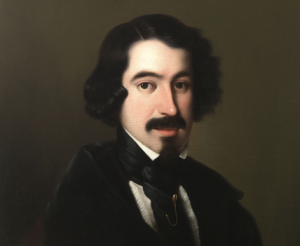José de Espronceda: Biography of the Romantic Poet

Many people know José de Espronceda’s poetry. His poetry consists of contrasts, descriptions, and an abundance of adjectives. Espronceda was inspired by historical figures and legendary stories.
He was a rebellious and desperate romantic who also participated in politics. Espronceda worked in several genres. For example, he wrote a novel, Sancho Saldaña, as well as plays and various newspaper articles. But perhaps he’s best known for his poetry.
In this article, we invite you to discover the life and work of José de Espronceda. If you learned “The Song of the Pirate” in school as a kid, perhaps you didn’t think too much of it. But now that you’re older, some questions arise: Why is the protagonist a pirate? Can a pirate be a romantic hero?

José de Espronceda’s life
José de Espronceda was born in Almendralejo, Extremadura, Spain, in 1808. Politics and literature marked his life. In his youth, he tried to avenge the death of Rafael del Riego. Likewise, he founded a secret revolutionary association that would lead him to become part of a monastery. At this time, he began to compose “Pelayo“, an epic poem about the Muslim conquest in Spain.
The contrast between his ideas and the reality of the country led him into exile. First, he moved to Gibraltar, then to Lisbon, and finally to London. He was imprisoned many times due to his ideology. After a visit to Paris, he returned to Spain.
Lord Byron clearly had an influence on Espronceda. Both quoted Plato and Horace, explained the sources of their poems, and were inspired by Aristotle. The literary critic Esteban Pujals dedicated a study to this relationship in his work Espronceda and Lord Byron (1951). In it, he also pointed out that while Byron stands out in the epic and the narrative aspects, Espronceda is superior as a lyric poet.
Similar to his literary career, he became very involved in politics. As a result of this, in his last month of life, he was a parliamentarian of the Progressive party. However, he died prematurely at the age of 34, as a result of diphtheria. At the time of his death, he had achieved great success and recognition as a great poet. Therefore, many people attended his funeral.
Classification of his poems
- Political, patriotic, and libertarian poems: In his poem “To the Fatherland”, he attacks the despotism of the rulers in Spain. In this same category, we also find the sonnet “To the Death of Torrijos and His Companions”.
- Poems about the hostility of the Romantics towards social conventions and their aspiration to absolute freedom: In this category, many poems stand out like “Under Sentence of Death,” “The Song of the Pirate,” or “The Executioner”. The poems are about outcasts. “The Cossack’s Song” has a social and humanitarian dimension.
- Philosophical poems: In this group, we can find “To Jarifa in an Orgy,” “To a Star,” and “Ode to the Sun.”
On the other hand, we could also include his transition poems. In other words, poems in which Espronceda imitates his role models.
“The Songs” of Espronceda
Setting aside “The Devil World”, “The Songs” are his most original work. There are six songs in total, and each introduces us to a different outcast. The first song is in his novel Sancho Saldaña and is called “The Captive”. Although it’s not the most innovative, it deals with issues such as rebellion and submission.
“The Song of the Pirate” is the most famous of the songs. In it, we finally see the exaltation of the Romantic hero. The protagonist is a pirate whose only goal is to live in freedom, without submitting to anybody. Not happy with the values of the world, he casts off into the sea, the most absolute freedom that can exist.
This is why many consider this to be the first Romantic Spanish poem. Additionally, Espronceda uses these protagonists to project his values. Like the pirate, he loved justice and freedom above all else. In “The Executioner,” he denounces injustice and excessively severe punishment in the justice system. He pled for punishments that fit the crime.
His heroes are symbolic projections of the poet’s own self. They represent symbols of individual rebellion against a wealthy bourgeoisie that lacks sensitivity. This is why he chooses outcasts, such as the beggar or the pirate, who live outside of the established norms. They denounce things they don’t like about the world they live in. Espronceda raised his flag along with the heroes who represent freedom.

Extensive poems by José de Espronceda
“The Student of Salamanca”
“The Student of Salamanca” (1840) is an extensive narrative poem that addresses the obsession of a character, Don Felix, to courting any lady in any situation. It consists of four parts: the presentation of the hero, portrait of the victim, Mrs. Elvira, revenge and death of the avenger, and, finally, the night tour of the city of Salamanca. This work highlights some of the main characteristics of Romanticism like the exaltation of the self, love for contrasts, absolute freedom, etc.
In the poem, Don Felix, the womanizer, falls in love with Doña Elvira. However, he forgets about her the next day, leaving her in deep pain which eventually leads to her death. Don Diego, Elvira’s brother, tries to avenge his sister’s death. From that moment on, magic takes over the story. Supernatural events occur throughout the night and mystery takes control of the verses.
“The Devil World”
“The Devil World” is a piece that José de Espronceda began to write in 1839 but didn’t get to finish before his death. It’s one of his most interesting and ambitious poems. It represents Espronceda’s pessimism in his final years.
It condemns the conservatives and explores issues such as freedom, the existence of God, etc. To Espronceda, there’s evil in every corner, even in the hearts of men. Hypocrisy and the ignorance of others’ pain have corrupted society. In this world, freedom seems to be inexistent and there is no room for purity or innocence.
“The Devil World” is a poem of rebellion against the established order, against the laws that govern the world. In his verses, Espronceda managed to express the desire for individual freedom.
Many people know José de Espronceda’s poetry. His poetry consists of contrasts, descriptions, and an abundance of adjectives. Espronceda was inspired by historical figures and legendary stories.
He was a rebellious and desperate romantic who also participated in politics. Espronceda worked in several genres. For example, he wrote a novel, Sancho Saldaña, as well as plays and various newspaper articles. But perhaps he’s best known for his poetry.
In this article, we invite you to discover the life and work of José de Espronceda. If you learned “The Song of the Pirate” in school as a kid, perhaps you didn’t think too much of it. But now that you’re older, some questions arise: Why is the protagonist a pirate? Can a pirate be a romantic hero?

José de Espronceda’s life
José de Espronceda was born in Almendralejo, Extremadura, Spain, in 1808. Politics and literature marked his life. In his youth, he tried to avenge the death of Rafael del Riego. Likewise, he founded a secret revolutionary association that would lead him to become part of a monastery. At this time, he began to compose “Pelayo“, an epic poem about the Muslim conquest in Spain.
The contrast between his ideas and the reality of the country led him into exile. First, he moved to Gibraltar, then to Lisbon, and finally to London. He was imprisoned many times due to his ideology. After a visit to Paris, he returned to Spain.
Lord Byron clearly had an influence on Espronceda. Both quoted Plato and Horace, explained the sources of their poems, and were inspired by Aristotle. The literary critic Esteban Pujals dedicated a study to this relationship in his work Espronceda and Lord Byron (1951). In it, he also pointed out that while Byron stands out in the epic and the narrative aspects, Espronceda is superior as a lyric poet.
Similar to his literary career, he became very involved in politics. As a result of this, in his last month of life, he was a parliamentarian of the Progressive party. However, he died prematurely at the age of 34, as a result of diphtheria. At the time of his death, he had achieved great success and recognition as a great poet. Therefore, many people attended his funeral.
Classification of his poems
- Political, patriotic, and libertarian poems: In his poem “To the Fatherland”, he attacks the despotism of the rulers in Spain. In this same category, we also find the sonnet “To the Death of Torrijos and His Companions”.
- Poems about the hostility of the Romantics towards social conventions and their aspiration to absolute freedom: In this category, many poems stand out like “Under Sentence of Death,” “The Song of the Pirate,” or “The Executioner”. The poems are about outcasts. “The Cossack’s Song” has a social and humanitarian dimension.
- Philosophical poems: In this group, we can find “To Jarifa in an Orgy,” “To a Star,” and “Ode to the Sun.”
On the other hand, we could also include his transition poems. In other words, poems in which Espronceda imitates his role models.
“The Songs” of Espronceda
Setting aside “The Devil World”, “The Songs” are his most original work. There are six songs in total, and each introduces us to a different outcast. The first song is in his novel Sancho Saldaña and is called “The Captive”. Although it’s not the most innovative, it deals with issues such as rebellion and submission.
“The Song of the Pirate” is the most famous of the songs. In it, we finally see the exaltation of the Romantic hero. The protagonist is a pirate whose only goal is to live in freedom, without submitting to anybody. Not happy with the values of the world, he casts off into the sea, the most absolute freedom that can exist.
This is why many consider this to be the first Romantic Spanish poem. Additionally, Espronceda uses these protagonists to project his values. Like the pirate, he loved justice and freedom above all else. In “The Executioner,” he denounces injustice and excessively severe punishment in the justice system. He pled for punishments that fit the crime.
His heroes are symbolic projections of the poet’s own self. They represent symbols of individual rebellion against a wealthy bourgeoisie that lacks sensitivity. This is why he chooses outcasts, such as the beggar or the pirate, who live outside of the established norms. They denounce things they don’t like about the world they live in. Espronceda raised his flag along with the heroes who represent freedom.

Extensive poems by José de Espronceda
“The Student of Salamanca”
“The Student of Salamanca” (1840) is an extensive narrative poem that addresses the obsession of a character, Don Felix, to courting any lady in any situation. It consists of four parts: the presentation of the hero, portrait of the victim, Mrs. Elvira, revenge and death of the avenger, and, finally, the night tour of the city of Salamanca. This work highlights some of the main characteristics of Romanticism like the exaltation of the self, love for contrasts, absolute freedom, etc.
In the poem, Don Felix, the womanizer, falls in love with Doña Elvira. However, he forgets about her the next day, leaving her in deep pain which eventually leads to her death. Don Diego, Elvira’s brother, tries to avenge his sister’s death. From that moment on, magic takes over the story. Supernatural events occur throughout the night and mystery takes control of the verses.
“The Devil World”
“The Devil World” is a piece that José de Espronceda began to write in 1839 but didn’t get to finish before his death. It’s one of his most interesting and ambitious poems. It represents Espronceda’s pessimism in his final years.
It condemns the conservatives and explores issues such as freedom, the existence of God, etc. To Espronceda, there’s evil in every corner, even in the hearts of men. Hypocrisy and the ignorance of others’ pain have corrupted society. In this world, freedom seems to be inexistent and there is no room for purity or innocence.
“The Devil World” is a poem of rebellion against the established order, against the laws that govern the world. In his verses, Espronceda managed to express the desire for individual freedom.
All cited sources were thoroughly reviewed by our team to ensure their quality, reliability, currency, and validity. The bibliography of this article was considered reliable and of academic or scientific accuracy.
- Pujals, E., (1951): Espronceda y Lord Byron. Madrid, Consejo Superior de Investigaciones Científicas.
This text is provided for informational purposes only and does not replace consultation with a professional. If in doubt, consult your specialist.







